Find out how quick and easy it is to use Alien Wavelengths on top of your DWDM network to increase your bandwidth.
1. What is an Alien Wavelength?
An “alien” wavelength is any wavelength that originates on networking equipment that is not the same as the equipment used in the optical line system. It can be from a different type of equipment such as a router with colored optics connected to an optical line system even if they are both from the same vendor. It also can be a wavelength that is launched from third party optical transport equipment (see Figure 1).
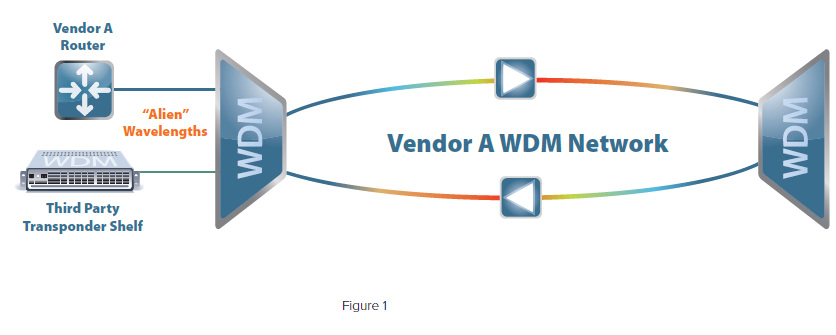
Alien wavelengths are used for a variety of reasons. One is that the existing line system may be limited to 40, 32 or even 16 wavelengths and may have no capability for expansion. Another is that the incumbent vendor may be charging too much money for additional transponders in an effort to recoup margin. Yet another reason may be because the incumbent vendor no longer exists or has been acquired by a competitor that the service provider doesn’t want in its network.
2. The Coherent Advantage
The alien wavelength market began with the introduction of 10G technology to add high capacity channels to existing lower speed 2.5G networks. However, the problem was that the fiber plant designed for 2.5G created chromatic dispersion problems for 10G channels. For this reason and because of the high cost of 10G technology at the time, alien wavelengths remained a niche application. With the introduction of coherent technology, the cost of high speed optical transport declined at a rate unprecedented in the history of the industry. In today’s market, 100G transport is available for over 40% less than the cost of 10G (see Figure 2), while 200G is half the cost driving it rapidly to becoming the de facto bit rate in metro, regional and even long haul transport networks.
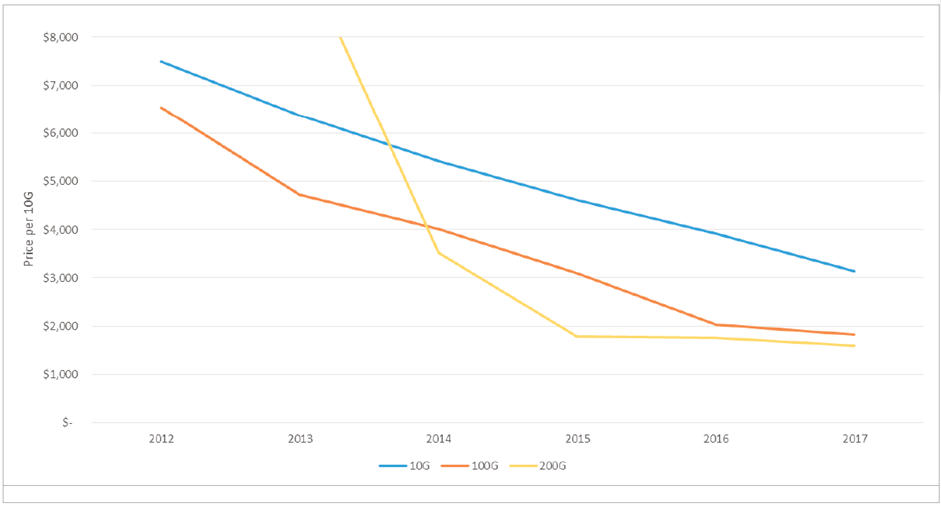
Another benefit of coherent technology is that it allows high speed channels—100G and above—to operate over spans with poor performance. Though optimized around the current generation of line systems, coherent technology allows 100G, 200G and higher line rates to also operate over line systems from previous generations that have difficulty even supporting lower speed 10G traffic. The ability of the Digital Signal Processor (DSP) to digitally correct the analog impairments that occur in optical networks allows these high speed channels to overcome any limitations imposed by the fiber plant.
Because they use coherent technology with different modulation techniques, high speed 100G, 200G, 400G or even 600G wavelengths have superior chromatic dispersion tolerances that allow them to more easily co-exist with the 10G wavelengths already operating on the line. Even in cases where the use of guard bands is required, the additional capacity gained from using the higher speed channels more than compensates for loss of a single guard band wavelength. Combined, these factors give coherent based solutions an enormous advantage over 10G from a cost vs. performance standpoint.
3. Relieving Fibre Exhaust
The main use case for alien wavelengths is relieving fiber exhaust. As networks reach their channel capacity limits, service providers are looking for ways to leverage the existing fiber plant. In most cases, the time and cost required to light a new fiber pair is prohibitively expensive. In some cases, the scarcity of fiber may make it impossible altogether. Alien wavelengths can provide the needed capacity at low cost and in a much shorter timeframe compared to lighting new fiber. Even in networks where capacity is completely exhausted, alien wavelengths can be used to replace existing low speed channels allowing the network operator to reclaim capacity on the existing line system (see Figure 3).
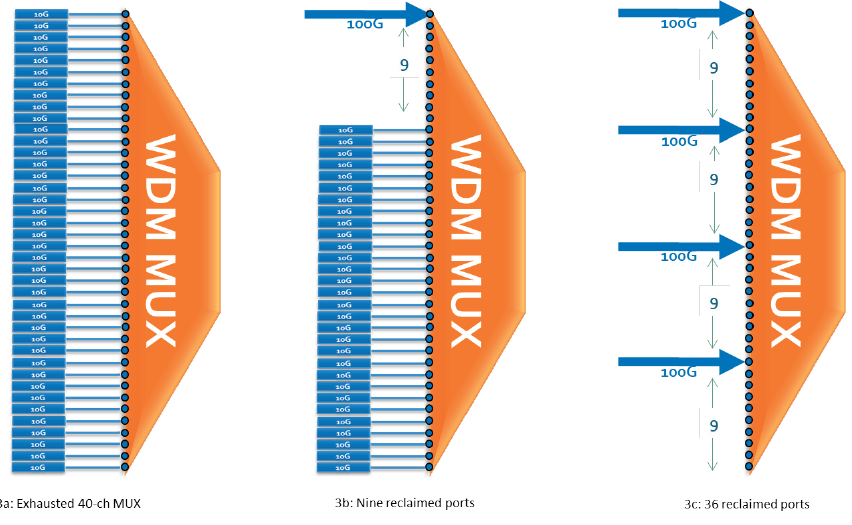
4. Ekinops Solution
With the cost of coherent technology continuing to fall and bandwidth continuing to grow, the market for ultra-high speed solutions is rapidly replacing 10G across metro, regional and core networks (see Figure 4). To meet this demand, Ekinops has developed a series of high speed line modules for its modular C600HC and C200HC chassis that address any application from very short metro access links to ultra-long haul spans.
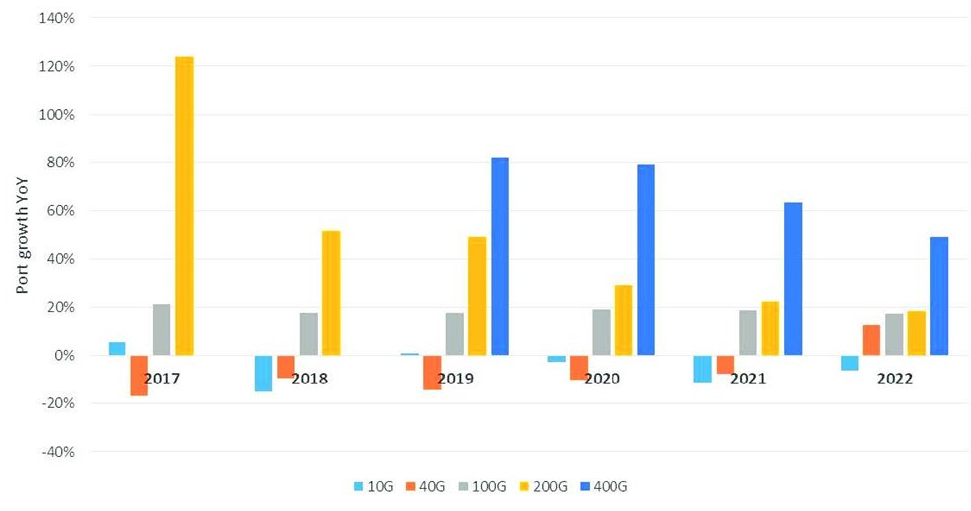
With bandwidth growth inevitable and ongoing, more link capacity will always be needed whether in the core, the metro or even the access portion of the network. As such, it is in the networks operator’s interest to deploy as much bandwidth as their budget will support to accommodate future growth. To address this need, Ekinops has developed its Flexrate line modules that have the ability to deliver anywhere from 100G to 600G of capacity simply by selecting the desired line rate and modulation format from the management interface. This flexibility allows the network operator to match capacity to current demand. For example, the PM 400FRS04 (see Figure 5) can be initially provisioned for 100G of capacity to meet immediate bandwidth needs and then re-programmed via software as demand grows without having to buy a new module or swap out hardware. The modulation format can also be set to meet certain reach requirements. For local access, the modulation format can be set to deliver 600G over shorter distances. Alternately it can be set to deliver 100G to reach ultra-long haul distances up to 10,000 Km, or any distance in between to optimize the capacity vs. reach trade-off.

For applications such as wireless backhaul where space availability is limited and where only a single high speed channel is required, the Ekinops RM 10001-WB and RM 10010-WB (see Figure 6) provide a 100G 1RU transponder and muxponder respectively with long haul transport capability up to 6000 Km.

5. Operational Advantages
With its ease of deployment over existing line systems combined with minimal space and power requirements, Ekinops alien wavelength solutions help save on operations costs in addition to the equipment savings they provide. All it requires is installing a small chassis (1RU or 2RU depending on your needs), connecting it to power, and connecting patch cables to the client device on one side and the existing optical multiplexer on the other. From there, it’s just a matter of establishing management connectivity— either in-band or out-of-band—and turning up the wavelength (see Figure 7). In band management simplifies operations because it only requires management connectivity to the near end. The embedded 10 Mbps Data Communications Channel (DCC) provides remote connectivity to the far end node without interfering with customer traffic.
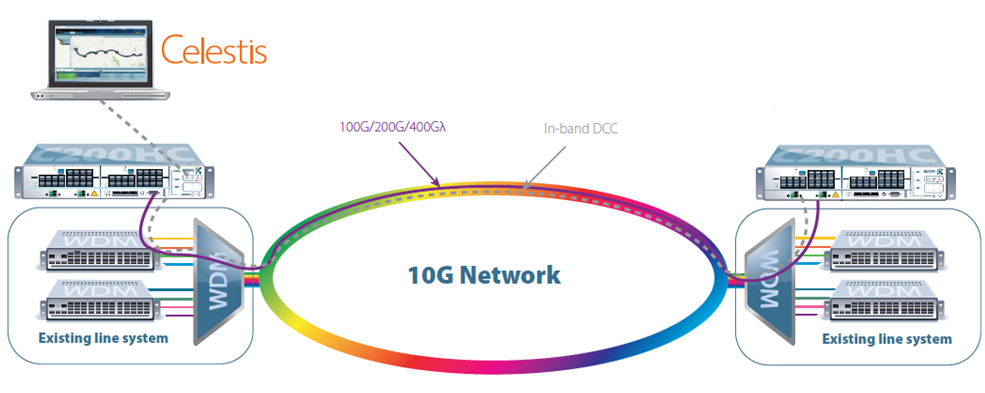
6. Platform Flexibility
EKINOPS360® Platform is purpose-built as a highly flexible system on several levels. The C600HC and C200HC chassis are modular units that can be customized to meet any service provider need or support any application simply by installing the service modules that best fit their needs. Multiprotocol client support for everything from 100M to 100G gives service providers the ability to support any type of service demand. Multilevel aggregation capability allows low speed services (FastE, GbE, OC-3/STM-1, OC-12/STM-4, SD/HD video etc.) to be carried on high speed wavelengths to maximize bandwidth utilization. With its “any card, any slot” design, the 360 Platform allows service providers to use any open slot to add capacity without restrictions. The same hardware and software technology is also used in our 1RU RM 10001-WB and RM 10010-WB units making them completely interoperable with the modular shelves extending the capabilities of the platform to space constrained locations. The EKINOPS360® Platform can operate on both dual fiber and single fiber networks making it highly adaptable to any network configuration.
7. Management
At the element level, the Flexrate modules as well as the RM 10001-WB and RM 10010-WB shelves can be managed through SNMP or via the Ekinops standard element level management interfaces, which includes a Command Line Interface (CLI) and an Ekinops Graphical User Interface (GUI). The CLI is accessible via SSH and Telnet remotely or via a local serial port locally. Complete performance monitoring and management is provided. Digital Diagnostics Management (DDM) is supported for pluggable client interfaces. A 10 Mb in-band Data Communications Channel (DCC) is embedded in the line side for remote management. All hardware elements are supported by EkiCraft, the Ekinops Craft Interface and Celestis NMS, the Ekinops network management system. SDNcapable, Ekinops solutions can also be managed using any controller via NETCONF interface in addition to Ekinops management tools. Celestis NMS easily integrates into any service provider management platform using standards-based northbound interfaces (NBI) to higher layer OSS/BSS systems.
8. Conclusion
Increasing bandwidth demand is a problem without end. Many existing WDM networks were not designed to meet today’s capacity needs and are quickly running out of room to grow. With the cost and time required to overbuild a new network, it is not a viable option in most cases. What is needed is a solution that can leverage the existing network by adding capacity on the current line system. Coherent technology makes it possible to add 100G, 200G, 400G and even 600G of capacity to 10G networks without disrupting existing wavelengths. The capacity, distance and cost advantages that coherent technology provides has transformed alien wavelengths from a niche application to a viable solution for capacity constrained networks. Ekinops 360 Platform, with its modular Flexrate and 1RU solutions, provides the highest performance and greatest flexibility available and can be easily deployed in any service provider network. The 360 Platform has a proven history of operating over any third-party line system, often outperforming the channels provided by the incumbent equipment vendor. With its broad service range and ease of management, Ekinops 360 is the solution of choice for alien wavelength applications.
Source: Ekinops
Contact us here:
